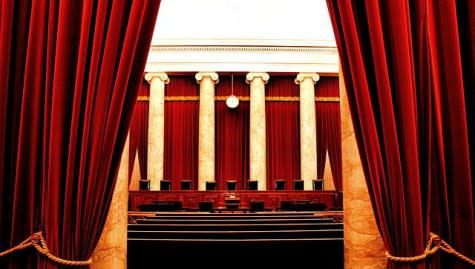Supreme Court refuses plea on Ohio voting
On the eve of the presidential election, the Supreme Court refused a Democratic party plea to intervene to protect Ohio voters from intimidation or harassment by followers of the Donald Trump presidential campaign. The state Democrats had asked the Justices to put back into effect a Cleveland federal judge’s order explicitly barring Trump “poll watchers” from impeding the voting process. That order had been blocked by a federal appeals court on Sunday.
Monday’s order by the Justices offered no explanation, but one member of the Court’s liberal bloc – Justice Ruth Bader Ginsburg – suggested one reason. She said that she voted with the full Court because she was “mindful” that state law in Ohio already prohibits intimidation of voters, making it a crime to take action to interfere with voting.
Although the Court has been asked several times recently – as it often is close to election days – to get involved in legal battles over this year’s voting, the Ohio Democrats’ request marked the first time it was asked to take steps directly against the Trump campaign in this year’s ballot process. The state Democrats had relied primarily upon candidate Trump’s repeated public statements calling on his supports to go to the polls to help protect against a “rigged” election – remarks that were widely regarded as targeting minority voters especially in urban areas.
The case on which it acted was titled Ohio Democratic Party v. Donald J. Trump for President. Some election observers had wondered whether Justice Ginsburg would take herself out of any action the Court might take that dealt with Trump’s candidacy because she had made public statements strongly critical of him (for which she then apologized). However, her public statement accompanying the Court’s order Monday afternoon made it clear that she felt no such obligation.
Her participation in the Ohio case also was a sign that she would be likely to take part if any legal battle over who won the presidency were to break out once Tuesday’s election was over.
The Court has long indicated that the federal courts should be very reluctant to get involved in disputes over election laws and procedures, when those disputes arise close to an election. Changing the rules when balloting is imminent, it has said, can cause serious confusion among voters.
The only issue technically before the Justices on Monday was whether to lift an order that the U.S. Court of Appeals for the Sixth Circuit had issued on Sunday morning, putting on hold the Cleveland trial judge’s order forbidding harassment and intimidation at the polls by Trump aides or followers.
The denial of the Democrats’ request does not prevent that party or its followers from pursuing legal remedies after the election is over, if they are able to demonstrate illegal interference with balloting.
Democratic party followers and civil rights groups have had mixed results this year in drawing the courts into controversies over so-called “ballot security” or “ballot integrity” efforts that Republican groups have carried out to deal with what the GOP has contended is fraud in voting.
Legendary journalist Lyle Denniston is Constitution Daily’s Supreme Court correspondent. Denniston has written for us as a contributor since June 2011 and he has covered the Supreme Court since 1958. His work also appears on lyldenlawnews.com.
Election Resources on Constitution Daily
A recent voting history of the 15 Battleground states
Explaining how recounts and contested presidential elections work


